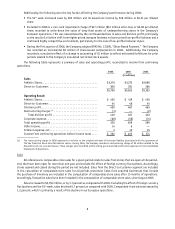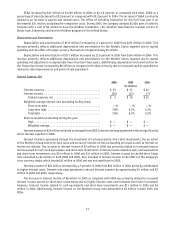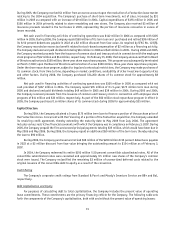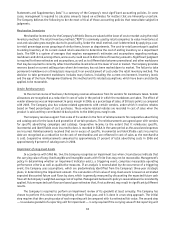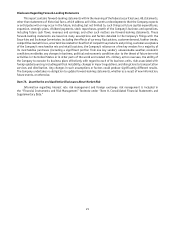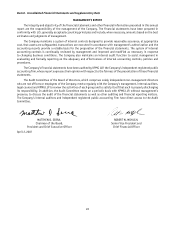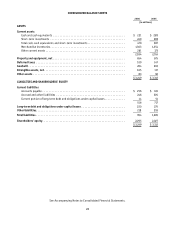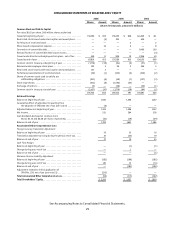Foot Locker 2006 Annual Report Download - page 35
Download and view the complete annual report
Please find page 35 of the 2006 Foot Locker annual report below. You can navigate through the pages in the report by either clicking on the pages listed below, or by using the keyword search tool below to find specific information within the annual report.
19
exceeds its estimated fair value. The fair value of each of the Company’s reporting units exceeded its carrying value as
of the beginning of the year. The Company used a combination of a discounted cash flow approach and market-based
approach to determine the fair value of a reporting unit. The latter requires judgment and uses one or more methods to
compare the reporting unit with similar businesses, business ownership interests or securities that have been sold.
During 2006, the Company recorded an impairment charge of $17 million ($12 million after-tax) to write-down
long-lived assets such as store fixtures and leasehold improvements in 69 stores in the European operations to their
estimated fair value.
Share-Based Compensation
The Company estimates the fair value of options granted using the Black-Scholes option pricing model. The
Company estimates the expected term of options granted using its historical exercise and post-vesting employment
termination patterns, which the Company believes are representative of future behavior. Changing the expected term by
one year changes the fair value by 10 to 15 percent depending if the change was an increase or decrease to the expected
term. The Company estimates the expected volatility of its common stock at the grant date using a weighted-average
of the Company’s historical volatility and implied volatility from traded options on the Company’s common stock. A 50
basis point change in volatility would have a 1 percent change to the fair value. The risk-free interest rate assumption
is determined using the Federal Reserve nominal rates for U.S. Treasury zero-coupon bonds with maturities similar
to those of the expected term of the award being valued. The expected dividend yield is derived from the Company’s
historical experience. A 50 basis point change to the dividend yield would change the fair value by approximately 5
percent. The Company records stock-based compensation expense only for those awards expected to vest using an
estimated forfeiture rate based on its historical pre-vesting forfeiture data, which it believes are representative of
future behavior, and periodically will revise those estimates in subsequent periods if actual forfeitures differ from
those estimates.
The Black-Scholes option valuation model requires the use of subjective assumptions. Changes in these
assumptions can materially affect the fair value of the options. The Company may elect to use different assumptions
under the Black-Scholes option pricing model in the future if there is a difference between the assumptions used in
determining stock-based compensation cost and the actual factors that become known over time.
The guidance in SFAS No. 123(R) is relatively new and best practices are not well established. The application of
these principles may be subject to further interpretation and refinement over time. There are significant differences
among valuation models and there is a possibility that the Company will adopt different valuation models and
assumptions in the future. This may result in both a lack of comparability with other companies that use different
models, methods, and assumptions, and in a lack of consistency in future periods.
Pension and Postretirement Liabilities
The Company determines its obligations for pension and postretirement liabilities based upon assumptions related
to discount rates, expected long-term rates of return on invested plan assets, salary increases, age, and mortality
among others. Management reviews all assumptions annually with its independent actuaries, taking into consideration
existing and future economic conditions and the Company’s intentions with regard to the plans. Management believes
that its estimates for 2006, as disclosed in “Item 8. Consolidated Financial Statements and Supplementary Data,” to be
reasonable.
Long-Term Rate of Return Assumption - The expected long-term rate of return on invested plan assets is a
component of pension expense and the rate is based on the plans’ weighted-average target asset allocation of 64 percent
equity securities and 36 percent fixed income investments, as well as historical and future expected performance of
those assets. The target asset allocation is selected to obtain an investment return that is sufficient to cover the
expected benefit payments based on the timing of settlements and to reduce future contributions by the Company.
The Company’s common stock represented approximately 1 percent of the total pension plans’ assets at February 3,
2007. A decrease of 50 basis points in the weighted-average expected long-term rate of return would have increased
2006 pension expense by approximately $3 million. The actual return on plan assets in a given year may differ from the
expected long-term rate of return and the resulting gain or loss is deferred and amortized into the plans’ performance
over time.


